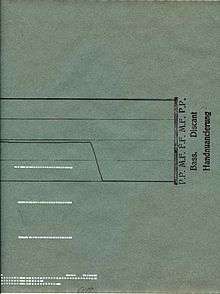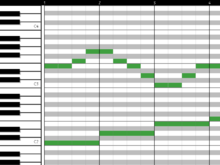Piano roll
A piano roll is a music storage medium used to operate a player piano, piano player or reproducing piano. Piano rolls, like other music rolls, are continuous rolls of paper with perforations (holes) punched into them. The perforations represent note control data. The roll moves over a reading system known as a 'tracker bar' and the playing cycle for each musical note is triggered when a perforation crosses the bar and is read.

Piano rolls have been in continuous production since at least 1896,[1][2] and are still being manufactured today; QRS Music offers 45,000 titles with "new titles being added on a regular basis",[3] although they are no longer mass-produced. MIDI files have generally supplanted piano rolls in storing and playing back performance data, accomplishing digitally and electronically what piano rolls do mechanically. MIDI editing software often features the ability to represent the music graphically as a piano roll.
The first paper rolls were used commercially by Welte & Sons in their orchestrions beginning in 1883.[4]
A rollography is a listing of piano rolls, especially made by a single performer, analogous to a discography.[5]
Buffalo Convention
The majority of piano rolls play on three distinct musical scales. The 65-note (with a playing range of A1 to C♯7) format was introduced in 1896 in the USA specifically for piano music. In 1900, an American format playing all 88 notes (A0 to C8) of the standard piano scale was introduced. In 1902, a German 72-note scale (F1, G1 to E7) was introduced. All of these scales were subject to being operated by piano rolls of varying dimensions and there was no real industry standard, until the 1908 Buffalo Convention of US manufacturers standardized the US industry to the 88-note scale and fixed the physical dimensions for that scale.

The Buffalo Convention of December 10, 1908[6] established two future roll formats for the US-producers of piano rolls for self-playing pianos. The two formats had different punchings of 65 and 88 notes, but the same width (11 1⁄4 inches or 286 millimetres); thus 65-note rolls would be perforated at 6 holes to the inch, and 88-note rolls at 9 holes to the inch, leaving margins at both ends for future developments. This made it possible to play the piano rolls on any self-playing instrument built according to the convention, albeit sometimes with a loss of special functionality. This format became a loose world standard.
Metronomic, hand played, and reproducing rolls
Metronomic or arranged rolls are rolls produced by positioning the music slots without real-time input from a performing musician. The music, when played back, is typically purely metronomical. Metronomically arranged music rolls are deliberately left metronomic so as to enable a player-pianist to create their own musical performance (such as varying the dynamics, tempo, and phrasing) via the hand controls that are a feature of all player pianos.
Hand played rolls are created by capturing in real time the hand-played performance of one or more pianists upon a piano connected to a recording machine. The production roll reproduced the real-time performance of the original recording when played back at a constant speed. (It became industry convention for recordings of music intended to be used for dancing to be regularized into strict tempo despite the original performance having the slight tempo fluctuations of all human performances, as due to the recording and production process, any fluctuations would be magnified/exaggerated in the finished production copy and result in an uneven rhythm.)
Reproducing rolls are the same as hand-played rolls but have additional control codes to operate the dynamic modifying systems specific to whichever brand of reproducing piano it is designed to be played back on, producing an approximation of the original recording pianist's dynamics. Reproducing pianos were beyond the reach of the average home in the original era of popularity of these instruments and were heavily marketed as reproducing the 'soul' of the performer – slogans such as "The Master's Fingers On Your Piano" or "Paderewski will play for you in your own house!" were common.
Compositions for pianola and reproducing piano
The player piano gives the opportunity to create music that is impossible for humans to play, or, more correctly, music that was not conceived in terms of performance by hand. Over one hundred composers wrote music specially for the player piano during the course of the 20th century. Many mainstream composers experimented with its possibilities, including Igor Stravinsky, Alfredo Casella, and Paul Hindemith; others, including Conlon Nancarrow, made it their primary milieu.
The Duo-Art, Ampico, and Welte-Mignon brands were known as "reproducing" piano rolls, as they could accurately reproduce the touch and dynamics of the artist as well as the notes struck, when played back on capable pianos.
Reproducing pianos
Rolls for the reproducing piano were generally made from the recorded performances of famous musicians. Typically, a pianist would sit at a specially designed recording piano, and the pitch and duration of any notes played would be either marked or perforated on a blank roll, together with the duration of the sustaining and soft pedal.
Reproducing pianos can also re-create the dynamics of a pianist's performance by means of specially encoded control perforations placed towards the edges of a music roll. Different companies had different ways of notating dynamics, some technically advanced, some secret, and some dependent entirely on a recording producer's handwritten notes, but in all cases these dynamic hieroglyphics had to be skillfully converted into the specialized perforated codes needed by the different types of instrument.
Recorded rolls play at a specific, marked speed, where for example, 70 signifies 7 feet (2.1 m) of paper travel in one minute, at the start of the roll. On all pneumatic player pianos, the paper is pulled on to a take-up spool, and as more paper winds on, so the effective diameter of the spool increases, and with it the paper speed. Player piano engineers were well aware of this, as can be seen from many patents of the time, but since reproducing piano recordings were generally made with a similar take-up spool drive, the tempo of the recorded performance is faithfully reproduced, despite the gradually increasing paper speed.
The playing of many pianists and composers is preserved on reproducing piano roll. Gustav Mahler, Camille Saint-Saëns, Edvard Grieg, Teresa Carreño, Claude Debussy, Manuel de Falla, Scott Joplin, Sergei Rachmaninoff, Sergei Prokofiev, Alexander Scriabin, Jelly Roll Morton and George Gershwin are amongst the composers and pianists who have had their performances recorded in this way.
Duo-Art featured artists such as Ignace Jan Paderewski, George Gershwin, Maurice Ravel, Teresa Carreño, Percy Grainger, Leopold Godowsky and Ferruccio Busoni. The Ampico brand's featured artists included Sergei Rachmaninoff, Ferde Grofé, Leo Ornstein, Mischa Levitzki, Winifred MacBride, and Marguerite Volavy. Welte-Mignon, the earliest reproducing system, recorded artists such as Gustav Mahler, Camille Saint-Saëns, Claude Debussy, Manuel de Falla, Alexander Scriabin, Enrique Granados, Eugen d'Albert, Josef Lhévinne, Raoul Pugno, and Carl Reinecke (who was the earliest-born pianist to record in any media format).
There were hundreds of companies worldwide producing rolls during the peak period of their popularity (1900–1927). Some other non-reproducing rolls makers of live performances are listed below together with their most memorable recording artistes.
- Aeolian: Pauline Alpert, Edythe Baker, Felix Arndt, Constance Mering, Frank Milne, Rube Bloom, Eubie Blake, Les Copeland
- QRS: James P Johnson, Fats Waller, Zez Confrey, Blind Boone, Lem Fowler, J. Lawrence Cook, Pete Wendling, Phil Ohman, Victor Arden, J. Russel Robinson
- Connorized; Scott Joplin
- Republic: Adrian Rollini
- US Music Roll Company; Lee Sims, Robert Billings
- Imperial — Charley Straight, Roy Bargy
- Vocalstyle — Jelly Roll Morton, Walter Davison, Clarence Jones, Luckey Roberts, Cow Cow Davenport, Amanda Randolph
- Capitol/Columbia; Jimmy Blythe, Clarence Johnson, Pearl White, Eddie Hanson
Legal protectability against copying
White-Smith Music Publishing Company v. Apollo Company, 209 U.S. 1 (1908), was a decision by the Supreme Court of the United States which ruled that manufacturers of music rolls for player pianos did not have to pay royalties to the composers. The ruling was based on a holding that the piano rolls were not copies of the plaintiffs' copyrighted sheet music, but were instead parts of the machine that reproduced the music.
This case was subsequently eclipsed by Congress's intervention in the form of an amendment to the Copyright Act of 1909, protecting them and introducing a compulsory license for the manufacture and distribution of such "mechanical" embodiments of musical works.
In digital audio workstations

In most modern digital audio workstation software, the term "piano roll" is used to refer to a graphical display of, and means of editing, MIDI note data; as well as entering the pitch, length and velocity of notes manually, instead of recording the output of a keyboard or other device for entering note data. Usually a means of manually editing other aspects of the MIDI data, such as pitch bend or modulation, is also present, although not strictly part of the piano roll itself.
See also
- Book music
- Music roll is the generic term for similar rolls used to operate fairground organs (or band organs), calliopes, hand-cranked organs, orchestrions and other types of automatically played pipe organ or mechanical organ.
- Scorewriter
- Virtual Studio Technology
- White-Smith Music Publishing Company v. Apollo Company
References
- "The Pianola Institute – History of the Pianola – Piano Players". www.pianola.org.
- "The day the music died". The Buffalo News. 10 June 2011.
- "Music". QRS Music. Retrieved 12 September 2010.
- "US Patent 287,599, Emil Welte, New York, 30 October 1883" (PDF). welte-mignon.de.
- Root, Deane L., ed. (2001). "Rollography". The New Grove Dictionary of Music and Musicians. Oxford University Press.
- Music Trade Review, New York, NY, Vol. 47, No. 24, p. 31 from December 12, 1908.
Sources
- Elaine Obenchain: The complete catalog of Ampico Reproducing Piano rolls. New York: American Piano Co., ca. 1977. ISBN 0-9601172-1-0; (out of print).
- Charles Davis Smith: Duo-Art piano music: a complete classified catalog of music recorded for the Duo-Art reproducing piano compiled and annotated by Charles Davis Smith. Monrovia, California, ca. 1987; (out of print).
- Charles David Smith and Richard James Howe: The Welte-Mignon, its music and musicians; complete catalogue of Welte-Mignon reproducing piano recordings 1905–1932, historical overview of companies and individuals, biographical essays on the recording artists and composers. Vestal, NY: Vestal Press, 1994. ISBN 1-879511-17-7; (out of print).
- Gerhard Dangel und Hans-W. Schmitz: Welte-Mignon-Reproduktionen: Gesamtkatalog der Aufnahmen für das Welte-Mignon Reproduktions-Piano 1905–1932 (Welte-Mignon Reproductions: Complete Library of Recordings for the Welte-Mignon Reproducing Piano 1905–1932). Stuttgart 2006. ISBN 3-00-017110-X
- Barbara Bryner: The piano roll: a valuable recording medium of the twentieth century. Dept. of Music, University of Utah, 2002. OCLC 50482085
- William Braid White: The player-piano up-to-date: a comprehensive treatise on the principles, construction, adjustment, regulation and use of pneumatic mechanisms for piano-playing: together with a description of the leading mechanisms now in use and some hints on the playing thereof. New York, Edward Lyman Bill, 1914 (The date of convention is given wrongly as 1909).
External links
| Look up piano roll in Wiktionary, the free dictionary. |
| Wikimedia Commons has media related to Piano rolls. |
- The Reproducing Piano Roll Foundation (dead link)
- The Player Piano Group – the main UK society
- The Pianola Forum – online discussion group
- QRS Piano Rolls
- Pianola.co.nz – Listen to MIDI files created by scanning player piano rolls
- Information about Welte-Mignon
- Warren Trachtman's Piano Roll Scanning Information Page
- Complete listing of all Welte-Mignon rolls
